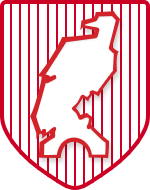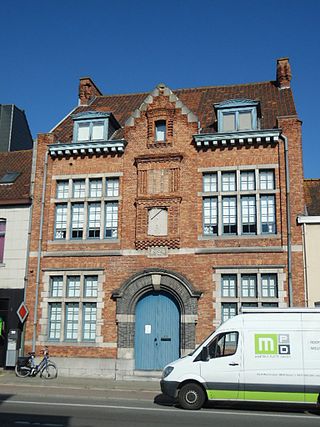
Sint Jansbrug is a student fraternity in the city of Delft in the Netherlands, founded in 1947. As of 2005, it has roughly 650 members, and owns two buildings in the Oude Delft, a street in the centre of Delft. Both are official monuments.

The official language of the Netherlands is Dutch, spoken by almost all people in the Netherlands. Dutch is also spoken and official in Aruba, Bonaire, Belgium, Curaçao, Saba, Sint Eustatius, Sint Maarten and Suriname. It is a West Germanic, Low Franconian language that originated in the Early Middle Ages and was standardised in the 16th century.

A rijksmonument is a national heritage site of the Netherlands, listed by the agency Rijksdienst voor het Cultureel Erfgoed (RCE) acting for the Dutch Ministry of Education, Culture and Science.

Saint Bernulf or Bernold of Utrecht was Bishop of Utrecht (1026/27–1054).

Sint-Petrus-en-Pauluskerk is a Roman Catholic church in Ostend, Belgium. The neo-Gothic building was constructed on the ashes of a previous church that occupied the site. King Leopold II enthusiastically supported a plan to build a new and more magnificent church. Construction started in 1899 and was completed and consecrated by Bishop Waffelaert on 31 August 1908. Its stained glass windows were destroyed during the two World Wars and were replaced by windows by Michiel Martens. The church is 70 metres (230 ft) long and 30 metres (98 ft) wide. Its spires are 72 metres (236 ft) high.

The Gertrudiskerk is a church approachable from the large market in the center of Bergen op Zoom, Netherlands. The towers of the church are called "pepper plant towers". An old legend says Saint Gertrude of Nivelles, abbess of the abbey in Nivelles, founded the church in 654.

The Cunerakerk is the main church of Rhenen, Netherlands. During the Middle Ages it was an important pilgrimage site. The church has stored the relics of the Saint Cunera since the 8th century. The tower has a height of 81.8 metres (268 ft).

Petegem-aan-de-Leie is a village in the Belgian province of East Flanders and a borough of Deinze. Petegem-aan-de-Leie is located on the south bank of the river Leie (Lys). The village today forms a single urban core with that of Deinze itself, which is located just across the river.

The church of Saint John the Baptist is a Roman Catholic church in Pijnacker in the Netherlands. The church is cruciform and built in the neo-Romanesque style. It was built in 1892 and is the work of architect, Adrianus Bleijs.

The Saint Remigius Church is a Roman Catholic church building in Simpelveld, The Netherlands. It is a neoroman cross shaped church with three naves, a tower with a waisted top, and a round apse. It is completely made up out of Kunradersteen, a local variant of chalk. The building is used as parish church for the local Saint Remigius parish. Patron saint for the church is Saint Remigius. Due to the inventory of the church, it has been listed as a rijksmonument, making it a national heritage site of the Netherlands.

The Moses and Aaron Church, in the Waterlooplein neighborhood of Amsterdam, is officially the Roman Catholic Church of St. Anthony of Padua. Originally a clandestine church, it was operated by Franciscan priests at a house on Jodenbreestraat ["Jewish Broad Street"], where the wall tablets of Moses and Aaron hung on the wall. In 1970, the present church was designated as a Cultural Heritage Monument of the Netherlands.

The Petrus en Pauluskerk is a church in Loppersum, Netherlands. It is a rijksmonument and in the Top 100 Dutch heritage sites.

St. Paul's Church is a Roman Catholic church located at the Veemarkt in Antwerp, Belgium. Its exterior is mainly Gothic with a Baroque tower while the interior is characterised by its rich Baroque decoration. It holds paintings by Antwerp's leading artists Peter Paul Rubens, Anthony van Dyck and Jacob Jordaens as well as abundant sculpture and church furniture crafted by leading Antwerp sculptors such as Artus Quellinus the Elder, Pieter Verbrugghen I, Jan Pieter van Baurscheit de Elder, Jan Claudius de Cock and Andries Colyns de Nole. Of particular note is the Calvary outside the Church which is made up of 63 life-size statues and nine reliefs executed in a popular and theatrical style.

The Saint Bernard Church is a Roman Catholic church building in Ubachsberg, Voerendaal, Netherlands. Patron saint for the church is Bernard of Clairvaux. The church is a national monument of the Netherlands.

Sint Martinus is a tower mill in Didam, Gelderland, Netherlands which was built in 1855 and has been restored to working order. The mill is listed as a Rijksmonument.

St. Paul's Abbey, Oosterhout, also Oosterhout Abbey is a former Benedictine abbey in Oosterhout, North Brabant, the Netherlands.

The St. Joseph Cathedral is the cathedral of the Roman Catholic Diocese of Groningen-Leeuwarden in the city of Groningen in the Netherlands.

The Saint Bavo Church is a Dutch Reformed church building in Aardenburg, Netherlands.

St Agnes Convent was a religious house of the Sisters of the Common Life in the city of Arnhem, in the Duchy of Guelders, in the 15th and 16th centuries.
Domien de Waghemakere, or Dominikus, was a Flemish architect and an important exponent of Brabantine Gothic.



























